Smartphone Audio Quality Testing
by Chris Heinonen on December 8, 2013 5:15 PM EST- Posted in
- Smartphones
- Audio
- Mobile
- Tablets
- Testing
THD+N is a measure of the total harmonic distortion and noise compared to the signal. The lower the number, the less distortion and noise there is relative to the fundamental frequency. THD+N is measured by driving a 1 kHz sine wave at maximum volume. Because there is always some inherent background noise, the THD+N is almost always lowest at maximum output so that is used for the measurement.
There are two results that we take from this: a sine wave and a FFT spectrum. On the sine wave both channels should line up perfectly, and it should be as close to an accurate sine wave as possible. On the FFT we want to see a peak at 1 kHz and everything else as low as possible. The most common artifact you will see are harmonic sidebands at multiples of 1 kHz.
For an example of data that looks good, here is the sine wave of the iPhone 5. We see a sine wave that is good, with channels that overlap perfectly and no deviation. This is what we expect to see.
Now for a different example we look at the Nexus 5. Run at maximum volume we see that the left channel is clipping in the sine wave. Likely the power to the headphone amplifier is not enough to drive both channels and so this is the result. UPDATE: Tested this with 4.4.1 and no change.
The iPhone 5 produces a THD+N ratio of 0.003134% while because of the clipping, the Nexus 5 is producing 13.789197%. Any level over 1% is considered to be past the clipping point of an amplifier and it seems that the Nexus 5 cannot be driven at maximum volume. I tested two samples to verify, and on both the performance is identical.
Now if we look at the FFT for this test, we see how this distortion is showing up. First, the iPhone 5 is very quiet.
There is a 2 kHz peak that is -93 dB below the fundamental frequency, and the 3rd harmonic at 3 kHz is over -109 dB below it. All the harmonics past that are at -120 dB below the fundamental tone. There is some noise out at 50 kHz but this is so far past the level of human hearing that it is safely ignored. Now the Nexus 5 FFT.
We see the right channel, which didn’t clip, looks good. The 2nd harmonic is -111 dB and the 3rd harmonic is -93 dB. On the left channel the 2nd harmonic is only -18 dB and the 3rd harmonic is -24 dB. Even at the 9th harmonic we are still only -52 dB below the fundamental tone. This is causing these incredibly high THD+N numbers that we are seeing on the Nexus 5. We will see more detail of this on a later test as well.
We also chart THD+N vs. Frequency. Here is the chart for the Note 3.
We see that THD+N is basically right below 0.08% for the whole spectrum. It moves up and down slightly, but is very constant. Now here is that Nexus 5 data.
We see that the right channel is around 0.01% THD+N while the left channel, the clipped one, is over 3%. If we ran the Nexus 5 at a lower volume level we would see totally different results, as you’ll find out later, but this is how devices are typically measured.


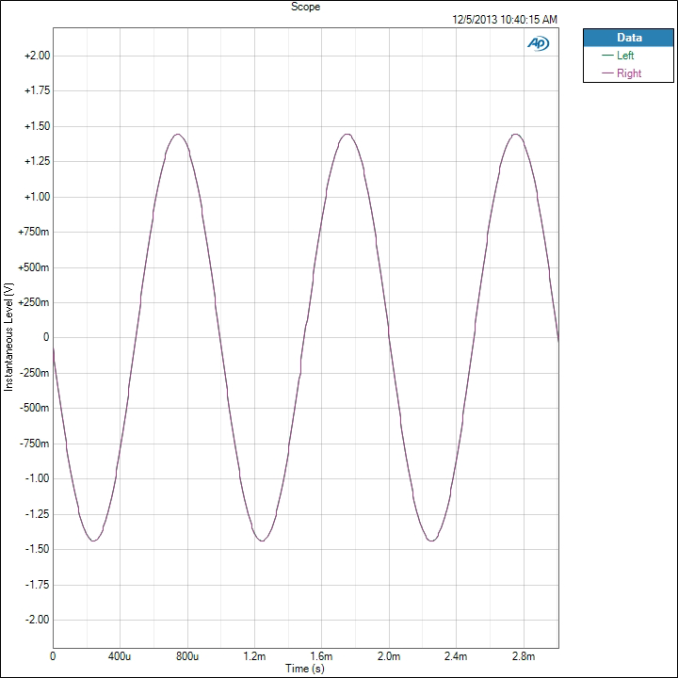
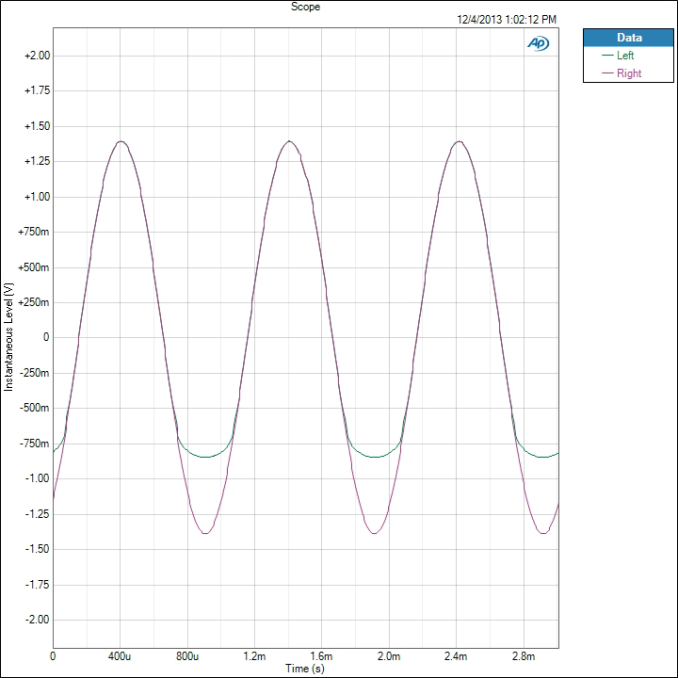
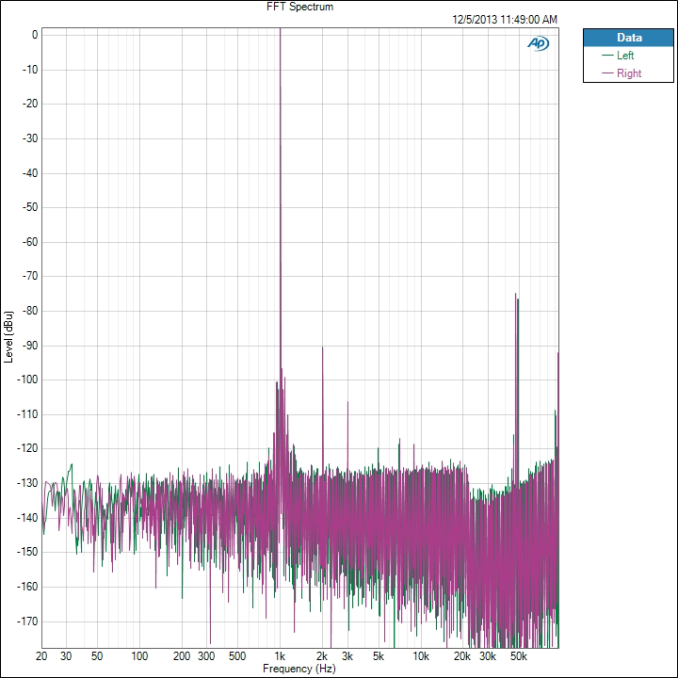
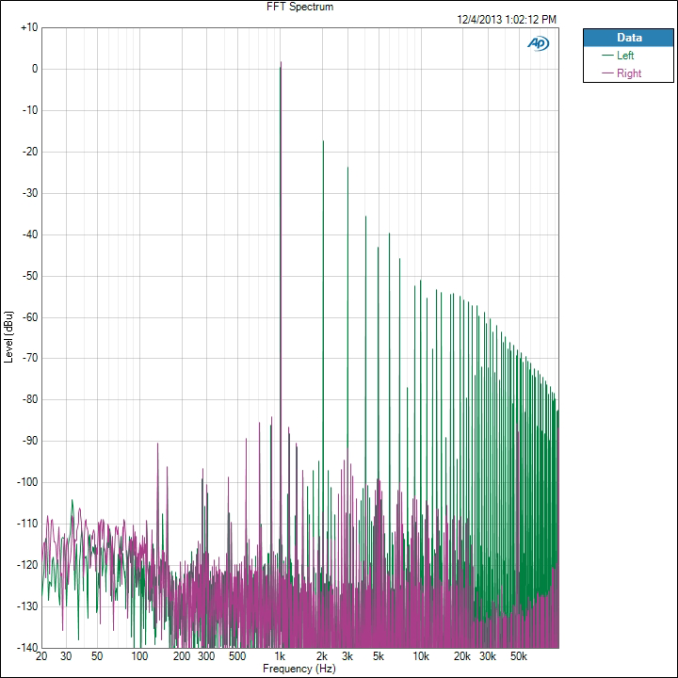
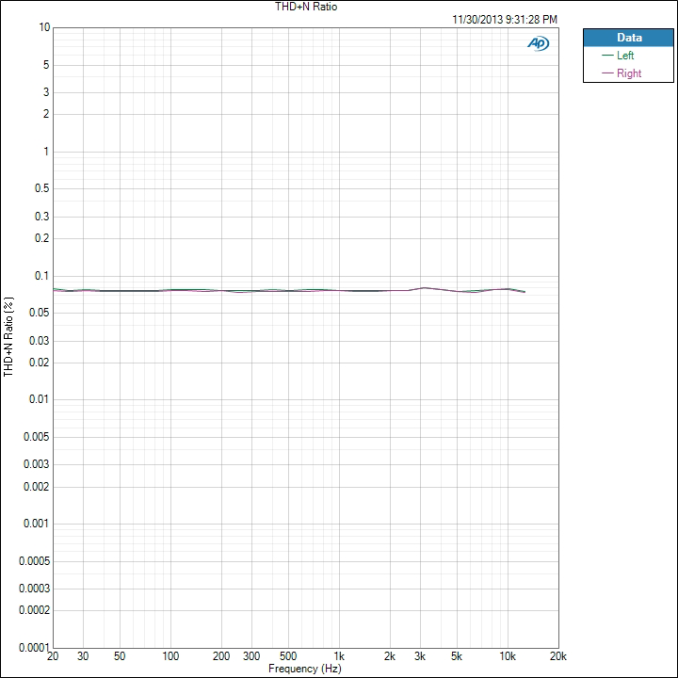









188 Comments
View All Comments
JasonQG - Monday, December 9, 2013 - link
I'll be curious to see how the iPhone 5s compares to the iPhone 5. I noticed a definite improvement when I upgraded, at least to my ears' perception.ClockHound - Tuesday, December 10, 2013 - link
Nice to hear you're taking sound semi-seriously with devices that have a semi-important audio task. At least for those who use smartphones for aural communication and music playback.Nice to see the Audio Precision in action. Great unit. However, please, consider putting a little more thought into the scaling of your FR graphs. What appears visually as a huge peak in the htc Beats graph barely has a 3dB rise. That's not a huge peak.
A 1dB rise at 10k is not much of a rise and since it doesn't display enough data, we can't tell if it's a low Q event or not.
The Audio Precision can scale the vertical axis to make plots more informative rather than sensational.
pandemonium - Tuesday, December 10, 2013 - link
Awesome stuff. Keep it up AT!kreacher - Tuesday, December 10, 2013 - link
Great article, would it be possible to test audio input (the mic) in this much detail. Noise cancellation as well as how it does in speakerphone mode / video recording. I know earlier reviews / articles have mentioned this are but it would be great to have detailed numbers like this article.Cyleo - Tuesday, December 10, 2013 - link
This is awesome. I truly love this, please continue this work ;)Any change one of the more recent Sony models makes the test (Xperia z comes to mind)
Pastuch - Tuesday, December 10, 2013 - link
Chris, fantastic article, way to bring me back to Anand. Please include results of the Iphone 4s and any other phones you get your hands on. My girlfriend and I are phone whores, she's Apple, I'm Android. I'm constantly playing with all of our phones and cans trying to find the best audio combo.I run Sennheiser HD-25s, Sennheiser Momentums, V-Moda Crossfade M-80s, and Koss Porta Pros (Awesome since the 80s!).
Best sounding phone I've ever heard:
Iphone 4S sounds way better than the new Iphone 5. It's definitely louder and fuller. Too bad the 4s doesn't have APT-X codec for Bluetooth.
Runner up:
Samsung Galaxy S with Voodoo sound Rom (Note, you need to load a non-standard rom to make it sound great)
The rest:
SGS2 (International Model): Too quiet, poor quality, disappointing dynamic range.
SGS3 (North American Model): Poor quality, lots of cross talk, disappointing dynamic range.
HTC One (Beats Audio OFF): Sounds great, really no complaints. A step above most Android phones. Still miss the Wolfson DAC though.
IPhone 5: Still sounds great but it doesn't live up to the 4S. I'd say it sounds slightly better than the HTC One but the difference is really marginal.
Nexus 5: Sounds better than the SGS2 or 3. The V-Moda M80s sound good because they aren't hard to drive. The Sennheiser HD25 needs the top volumes and the clipping is obvious. The HTC One sounds a little better.
vision33r - Tuesday, December 10, 2013 - link
HTC One audio is a joke. Which features a software sound enhancer AKA Beats Audio which any custom rom can cook into their roms.I've had the S3 with the Beats Audio software and took it off flashed a better DAC amp app.
Traum - Tuesday, December 10, 2013 - link
As a head-fi audiophile, I want to THANK YOU for doing this!MWisBest - Tuesday, December 10, 2013 - link
Nice article, definitely curious as to how my Galaxy Nexus would fare in this, as I'm a bit of an audiophile.hrrmph - Wednesday, December 11, 2013 - link
Awesome topic and write-up :)Keep these coming, please.